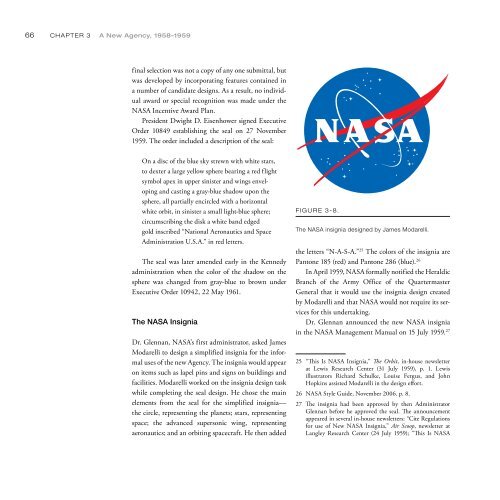You also want an ePaper? Increase the reach of your titles
YUMPU automatically turns print PDFs into web optimized ePapers that Google loves.
66 CHAPTER 3 A New Agency, 1958–1959<br />
final selection was not a copy of any one submittal, but<br />
was developed by incorporating features contained in<br />
a number of candidate designs. As a result, no individual<br />
award or special recognition was made under the<br />
NASA Incentive Award Plan.<br />
President Dwight D. Eisenhower signed Executive<br />
Order 10849 establishing the seal on 27 November<br />
1959. The order included a description of the seal:<br />
On a disc of the blue sky strewn with white stars,<br />
to dexter a large yellow sphere bearing a red flight<br />
symbol apex in upper sinister and wings enveloping<br />
and casting a gray-blue shadow upon the<br />
sphere, all partially encircled with a horizontal<br />
white orbit, in sinister a small light-blue sphere;<br />
circumscribing the disk a white band edged<br />
gold inscribed “National Aeronautics and Space<br />
Administration U.S.A.” in red letters.<br />
The seal was later amended early in the Kennedy<br />
administration when the color of the shadow on the<br />
sphere was changed from gray-blue to brown under<br />
Executive Order 10942, 22 May 1961.<br />
The NASA Insignia<br />
Dr. Glennan, NASA’s first administrator, asked James<br />
Modarelli to design a simplified insignia for the informal<br />
uses of the new Agency. The insignia would appear<br />
on items such as lapel pins and signs on buildings and<br />
facilities. Modarelli worked on the insignia design task<br />
while completing the seal design. He chose the main<br />
elements from the seal for the simplified insignia—<br />
the circle, representing the planets; stars, representing<br />
space; the advanced supersonic wing, representing<br />
aeronautics; and an orbiting spacecraft. He then added<br />
FIGURE 3-8.<br />
The NASA insignia designed by James Modarelli.<br />
the letters “N-A-S-A.” 25 The colors of the insignia are<br />
Pantone 185 (red) and Pantone 286 (blue). 26<br />
In April 1959, NASA formally notified the Heraldic<br />
Branch of the Army Office of the Quartermaster<br />
General that it would use the insignia design created<br />
by Modarelli and that NASA would not require its services<br />
for this undertaking.<br />
Dr. Glennan announced the new NASA insignia<br />
in the NASA Management Manual on 15 July 1959. 27<br />
25 “This Is NASA Insignia,” The Orbit, in-house newsletter<br />
at Lewis Research Center (31 July 1959), p. 1. Lewis<br />
illustrators Richard Schulke, Louise Fergus, and John<br />
Hopkins assisted Modarelli in the design effort.<br />
26 NASA Style Guide, November 2006. p. 8.<br />
27 The insignia had been approved by then Administrator<br />
Glennan before he approved the seal. The announcement<br />
appeared in several in-house newsletters: “Cite Regulations<br />
for use of New NASA Insignia,” Air Scoop, newsletter at<br />
Langley Research Center (24 July 1959); “This Is NASA


